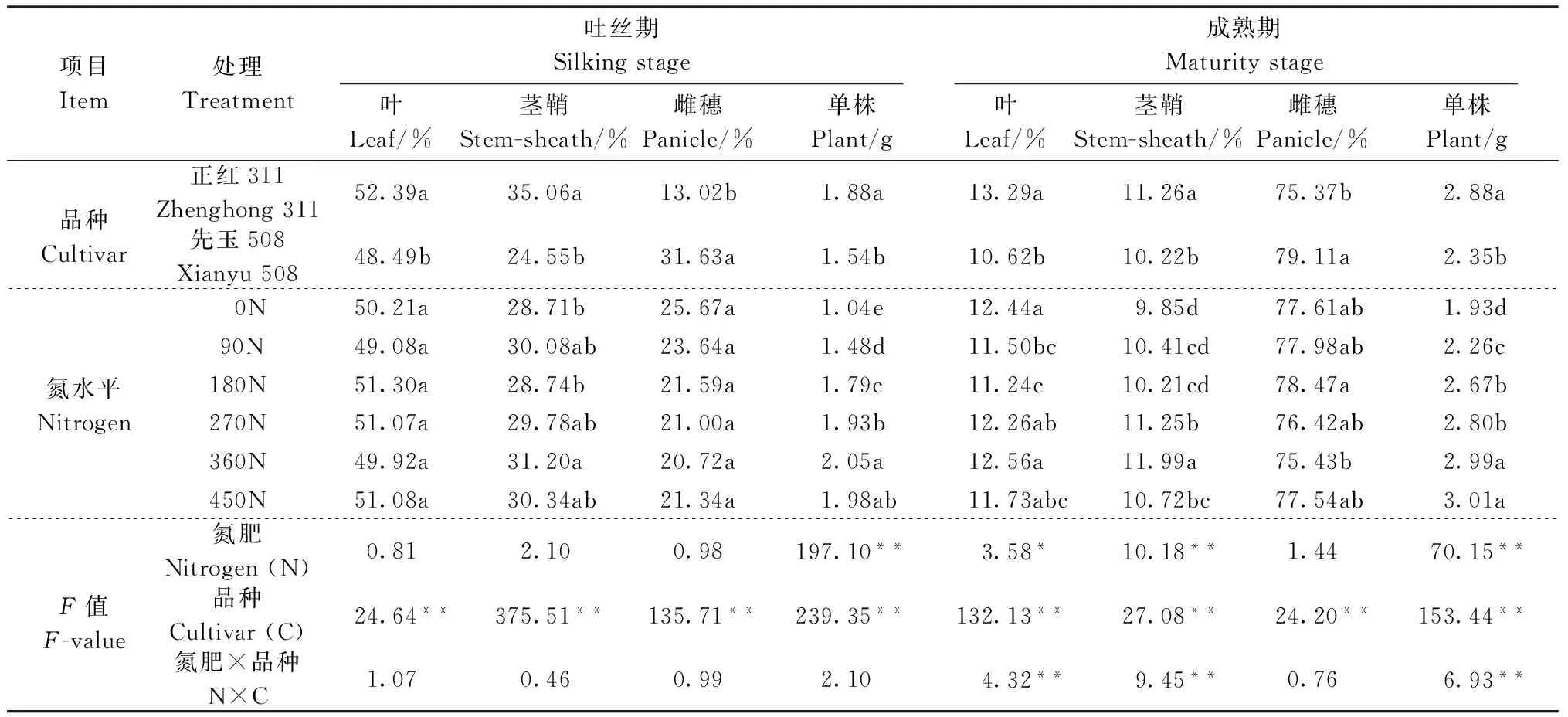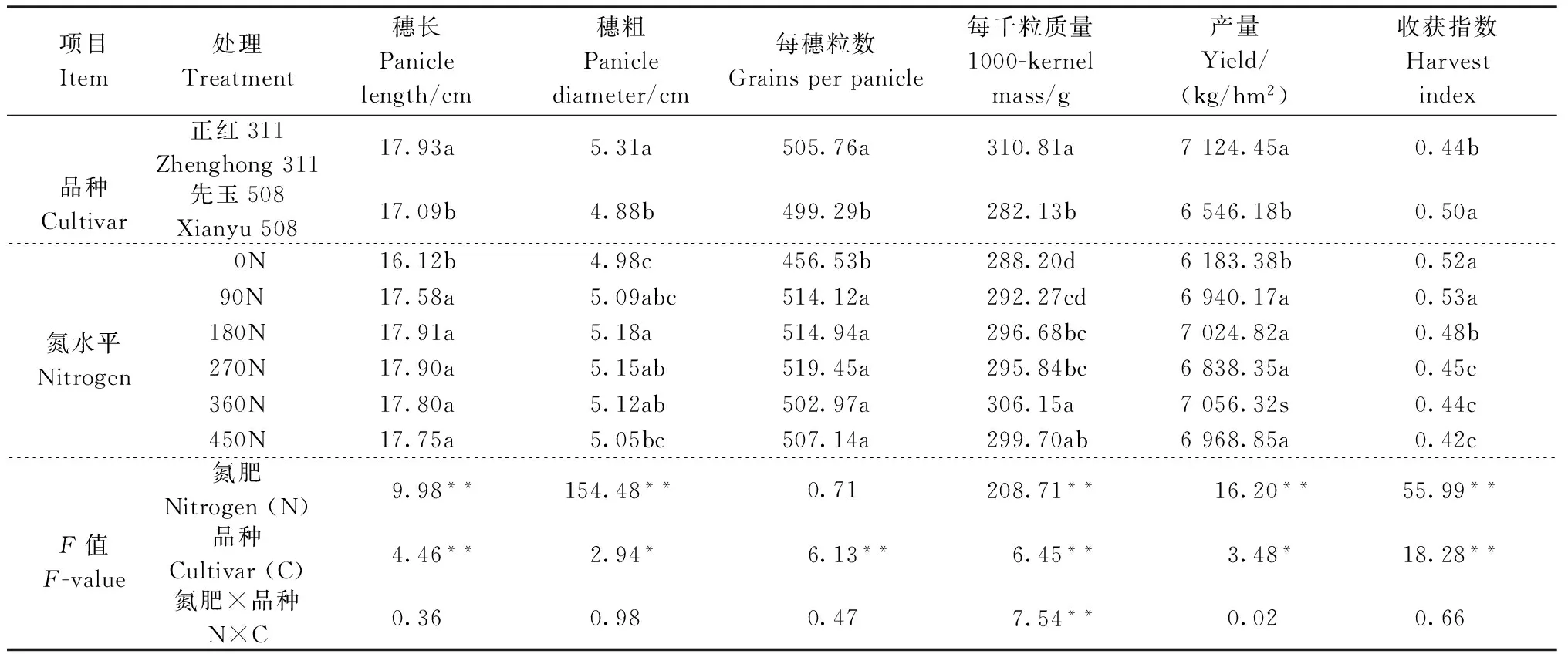氮肥对不同耐低氮性玉米品种干物质及氮素积累与分配的影响
李强, 马晓君, 程秋博, 豆攀, 余东海, 罗延宏, 袁继超, 孔凡磊*
(1.农业部西南作物生理生态与耕作重点实验室/四川农业大学农学院,成都 611130; 2.眉山市东坡区农业技术推广站,四川 眉山620032;3.四川省烟草公司宜宾市公司烟叶生产技术推广应用中心,四川 宜宾644002)
氮肥对不同耐低氮性玉米品种干物质及氮素积累与分配的影响
李强1, 马晓君1, 程秋博1, 豆攀1, 余东海2, 罗延宏3, 袁继超, 孔凡磊1*
(1.农业部西南作物生理生态与耕作重点实验室/四川农业大学农学院,成都 611130; 2.眉山市东坡区农业技术推广站,四川 眉山620032;3.四川省烟草公司宜宾市公司烟叶生产技术推广应用中心,四川 宜宾644002)
选用前期筛选出的玉米耐低氮品种正红311和低氮敏感品种先玉508为试验材料,采用裂区试验在6个氮水平下研究不同耐低氮性玉米品种的生长发育、干物质及氮素积累与分配差异。结果表明:正红311各阶段干物质及氮素积累量和积累速率、各时期茎鞘和叶片干物质及氮素分配比例均高于先玉508,而先玉508雌穗干物质及氮素分配比例更高。与先玉508相比,正红311提高了各主要生育时期叶片干物质及氮素积累量与分配比例,降低了雌穗干物质及氮素积累量与分配比例。正红311营养器官较高的干物质及氮素积累与分配比例有利于其保持较高的养分吸收和干物质生产能力,延缓叶片的衰老和延长高光合速率使其产量显著高于先玉508。施氮可显著提高玉米株高、茎粗、叶面积、干物质积累、氮素吸收、产量及产量构成,而对干物质和氮素在各器官的分配比例影响较小。过量施氮不仅不利于玉米生长发育,还会使玉米收获指数显著降低,从而不利于产量的提高。正红311施氮量在180 kg/hm2时产量最佳,而先玉508需要氮肥360 kg/hm2才能充分发挥其产量潜力。因此对于耐低氮品种正红311可适当降低施氮量或在土壤贫瘠的丘陵山区种植以充分发挥其低氮条件下的产量优势,而低氮敏感品种先玉508则应适当增加施氮量或种植在肥沃土壤的地区以保证其高产稳产。
氮肥; 玉米; 干物质; 积累与分配
随着玉米生产的发展,玉米已逐渐成为我国种植面积第一的粮食作物[1]。西南地区作为我国玉米第二大主产区,其玉米的高产稳产对于我国粮食安全具有重要意义[2-4]。增施氮肥是提高玉米产量最直接也是最简单的方式,所以农民在玉米生产中常常过量施用氮肥,不仅增加了玉米生产成本、降低氮肥利用效率,还造成资源浪费和环境污染问题[5-6]。因此,优化施氮用量、提高氮素利用效率已成为我国玉米高产高效栽培的研究热点[7-9]。前人研究表明,不同玉米品种对氮素的吸收利用特性差异显著[8,10-11];同一玉米品种在不同生态条件下对氮肥的响应也存在明显的差异[12-16]。
不同耐低氮性玉米品种的物质生产与氮肥利用特性差异显著,耐低氮玉米品种可以通过维持灌浆期绿叶面积来提高生育后期植株对氮素的吸收[10-11,17-19]。李文娟等[10]、崔超等[17]、陈范骏等[20]指出耐低氮玉米品种干物质积累量和氮素积累量均显著高于低氮敏感品种,且这种差异主要来自吐丝后。前人对于不同耐低氮性玉米品种干物质及氮素积累差异做了较多研究[10,12,17,21],但主要集中于北方地区,单一氮肥水平下干物质和氮素积累量上的比较,少有涉及器官分配问题[8,10,17],且鲜见西南丘陵山区不同耐低氮性玉米品种的物质及氮素积累与分配利用差异的比较研究。本试验在6个氮水平下,研究了不同耐低氮性玉米品种的干物质及氮素积累与分配特性,以期为西南丘陵山区根据玉米品种特性制定合理施氮技术提供理论依据。
1 材料与方法
1.1 试验材料
前期试验筛选出的耐低氮品种“正红311”和低氮敏感品种“先玉508”[22-23]。
1.2 试验时间与地点
2013年3—8月,四川省简阳市芦葭镇英明村,位于东经104.53°,北纬30.38°N,海拔429 m,试验期间气象数据见图1。

图1 试验期间气象资料Fig.1 Meteorological data during the experimental period
1.3 试验设计
采用裂区试验设计,主区为品种,分别为耐低氮品种正红311和低氮敏感品种先玉508;副区为施肥(纯氮)水平,设0N-0 kg/hm2、90N-90 kg/hm2、180N-180 kg/hm2、270N-270 kg/hm2、360N-360 kg/hm2和450N-450 kg/hm2共6个水平,重复3次,共36个小区,小区面积20 m2(长5 m,宽4 m)。供试土壤基础肥力(0~20 cm):有机质16.60 g/kg,全氮1.24 g/kg,全磷0.73 g/kg,全钾12.54 g/kg,碱解氮25.22 mg/kg,速效磷13.54 mg/kg,速效钾138.75 mg/kg,pH 8.63。玉米直播(穴播3粒再定苗),单株栽培,行穴距为(1.5 m+0.5 m)×0.2 m,种植密度为50 000株/hm2。氮肥(尿素,46%)用量按底肥∶穗肥(攻苞肥)1∶1施用,另施过磷酸钙600 kg/hm2、氯化钾150 kg/hm2作底肥;其他栽培管理措施按当地高产要求进行,小区间保持一致。
1.4 植株取样与测定
分别于玉米拔节期、吐丝期、灌浆期(吐丝后20 d)、成熟期每小区取代表性植株4株,先用长宽法测定叶面积,然后按器官(茎鞘、叶、雄穗和雌穗)分样,于105 ℃下杀青30 min,然后80 ℃烘干至恒重称量。
将烘干称量后样品用高速粉碎机粉碎,过80目筛后用塑封袋保存用于测定全氮含量。采用凯氏定氮法测定样品全氮含量[24-25]。
统计收获前每小区有效穗数、空秆率和双苞率,各小区选取连续20株进行考种,考察穗长、穗粗、秃尖长、穗行数、行粒数、单穗质量、穗粒数、千粒质量等,然后分小区实收计产。
1.5 数据分析
采用Excel 2007和SPSS 20.0统计分析软件进行数据处理和统计分析,并用LSD法进行差异显著性检验,显著水平设为P<0.05。
2 结果与分析
2.1 氮肥对不同耐低氮性玉米品种茎叶生长的影响
施用氮肥显著影响玉米主要生育时期形态指标,且不同耐低氮性玉米品种形态指标对氮肥的响应差异显著(表1)。耐低氮品种正红311各时期株高、叶面积均显著高于低氮敏感品种先玉508,其中正红311各形态指标随施氮量增加而先增后减,且在中高氮(270N、360N)水平下优势明显;而先玉508各形态指标在试验设计内随施氮量增加而增加,在高氮(450N)处理下生长旺盛。与0N相比,施氮处理下耐低氮品种正红311拔节期平均株高、茎粗、叶面积分别升高了6.9%、6.7%和6.0%,吐丝期分别升高了4.6%、1.5%和16.2%;低氮敏感品种先玉508拔节期分别升高了8.4%、4.2%和11.8%,吐丝期分别升高了5.7%、13.3%和43.0%。表明氮肥对低氮敏感品种先玉508形态指标的促进作用大于耐低氮品种正红311,正红311在中低氮水平下能更好地维持各形态指标的正常生长。从表1可以看出,玉米形态指标受品种类型和氮肥用量的影响显著,且吐丝期株高受品种类型和施氮量互作影响显著。
2.2 氮肥对不同耐低氮性玉米品种干物质积累与分配的影响
玉米生长过程主要包括营养生长期(播种—拔节)、营养与生殖生长并进期(拔节—吐丝)和生殖生长期(吐丝—成熟)3个阶段,2个供试品种在不同氮水平下各生育阶段干物质积累量和生长率差异显著(表2)。正红311和先玉508干物质积累量和生长率均在吐丝—灌浆期最高,分别积累了全生育期干物质的30.2%和39.3%,耐低氮品种正红311各阶段干物质积累量和生长率均显著高于低氮敏感品种先玉508,在生育后期(灌浆—成熟期)干物质积累和生长率正红311较先玉508分别高出110.5%和110.9%。

表1 氮肥对玉米生长的影响
同列数据后的不同小写字母表示同一项目不同处理间在P<0.05水平差异有统计学意义.*相关性显著(P<0.05);**相关性极显著(P<0.01).
Values within a column followed by different lowercase letters show significantly differences of the same item among different treatments at the 0.05 probability level. Single asterisk (*) and double asterisks (**) indicate significant correlations at the 0.05 and 0.01 probability levels, respectively.

表2 不同处理玉米主要生育阶段干物质积累量和生长率
DMA:干物质积累量;CGR:作物生长率.同列数据后的不同小写字母表示同一项目不同处理间在P<0.05水平差异有统计学意义.*相关性显著(P<0.05);**相关性极显著(P<0.01).
DMA: Dry matter accumulation; CGR: Crop growth rate. Values within a column followed by different lowercase letters show significantly differences of the same item among different treatments at the 0.05 probability level. Single asterisk (*) and double asterisks (**) indicate significant correlations at the 0.05 and 0.01 probability levels, respectively.
施氮显著提高了玉米各阶段的干物质积累量和生长率,2个品种平均播种—拔节期、拔节—吐丝期、吐丝—灌浆期和灌浆—成熟期5个氮肥处理平均干物质积累量分别较对照高17.6%、18.9%、51.7%和15.0%,以吐丝—灌浆期的促进作用最大。进一步分析发现,氮肥对2个参试品种各生育时期干物质积累量和生长率的影响程度和规律不尽一致,总体而言,耐低氮正红311各生育阶段的干物质积累量随氮肥水平的增加先增后降,而耐肥品种先玉508则随氮肥水平的增加呈增加趋势,尤其是生育后期。耐低氮品种正红311吐丝—成熟期和全生育期(即成熟期)单株干物质积累量(y)与施氮量(x)之间呈二次凸函数关系,回归方程分别为y=122.26+0.398 3x-0.000 502x2(R2=0.973 0**)和y=234.49+0.523 1x-0.000 675x2(R2=0.973 3**),分别在396.7 kg/hm2和387.4 kg/hm2最高,而耐肥品种先玉508吐丝—成熟期和全生育期(即成熟期)单株干物质积累量(y)与施氮量(x)之间呈一次函数关系,回归方程分别为y=105.78+0.104 6x(R2=0.947 8**)和y=202.76+0.146 3x(R2=0.936 7**),在试验处理范围内以氮肥水平450 kg/hm2为最高。
品种类型和氮肥施用对玉米干物质积累与分配影响显著,且品种类型的影响显著高于氮肥施用(表3)。耐低氮品种正红311吐丝期和成熟期干物质积累均显著高于低氮敏感品种先玉508,分别高出19.9%和28.2%,表明随生育进程2个品种干物质积累差异加大。施氮显著提高了2个品种吐丝期和成熟期的干物质积累,与0N相比,正红311吐丝期和成熟期在施氮处理下干物质积累平均分别升高了14.3%和32.2%,而先玉508升高了21.8%和23.2%,表明施氮有利于先玉508生育前期干物质积累,而对正红311生育后期干物质积累促进作用较大。
吐丝期和成熟期正红311营养器官(茎鞘、叶片)干物质分配比例均显著高于先玉508,表明正红311较先玉508具有更高的干物质生产能力。施氮显著影响玉米成熟期叶片及雌穗干物质分配,而对茎鞘干物质分配影响不显著。与0N相比,2个供试品种各施氮处理成熟期叶片干物质分配比例平均下降了11.5%,雌穗分配比例升高了3.8%,表明施氮可降低成熟期叶片的干物质分配比例以提高向雌穗的分配,从而提高产量。氮肥对玉米叶片干物质分配比例的影响表现出随施氮量增加而先增后减的趋势,在270N处理下叶片干物质分配比例降幅最大,雌穗干物质分配比例增幅最大。因此,合理施用氮肥可以降低成熟期叶片分配比例,增加雌穗分配比例,但过量施用氮肥致叶片分配比例有所上升反而不利于雌穗干物质分配的提高。

表3 不同处理玉米各时期单株干物质及在叶片、茎鞘和穗分配情况
同列数据后的不同小写字母表示同一项目不同处理间在P<0.05水平差异有统计学意义.**相关性极显著(P<0.01).
Values within a column followed by different lowercase letters show significantly differences of the same item among different treatments at the 0.05 probability level. Double asterisk (**) indicates highly significant correlation at the 0.01 probability level.
2.3 氮肥对不同耐低氮性玉米品种氮素积累与分配的影响
品种类型和氮肥施用对玉米各阶段氮素积累量和积累速率影响显著(表4)。从全生育期来看,正红311的氮素积累总量高于先玉508,平均高23.3%,表明正红311有更强的氮素吸收能力,这可能是其耐低氮的主要机制。从各生育阶段来看,2个供试品种氮素积累量均在播种—拔节期最高,拔节—吐丝期最低;正红311氮素积累速率在播种—拔节期最低,而先玉508在播种—拔节期最高;表明先玉508氮素积累高峰出现在营养生长期(播种—拔节期),而正红311氮素积累高峰在营养生长与生殖生长并进期(拔节—吐丝期),且在生殖生长期(吐丝—成熟期)也保持较高的氮素积累速率。生育中后期(拔节—成熟期)正红311氮素积累量和积累速率均显著高于先玉508,而在生育早期2个品种氮素积累量和积累速率差异不显著,表明2类品种氮素积累差异主要由生育中后期氮素积累差异引起。
氮肥水平显著影响2个品种各生育阶段的氮素吸收积累量和积累速率,在吐丝前,2个品种的氮素积累量均随施氮量的增加而呈先增后减趋势,二者之间呈极显著的二次凸函数关系;但吐丝后的氮素积累量则均随施氮量的增加而呈增加趋势,二者间呈显著正相关关系,其中正红311随施氮水平增加的增幅大大高于先玉508。

表4 玉米不同氮水平下主要生育阶段氮素积累量和积累速率
NA:氮素积累量;NAR:氮素积累速率.同列数据后的不同小写字母表示同一项目不同处理间在P<0.05水平差异有统计学意义.**相关性极显著(P<0.01).
NA: Nitrogen accumulation; NAR: Nitrogen accumulation rate. Values within a column followed by different lowercase letters show significantly differences of the same item among different treatments at the 0.05 probability level. Double asterisk (**) indicates highly significant correlation at the 0.01 probability level.
养分在植株各器官的积累分配是植株生长发育的物质基础,结果(表5)表明,玉米吐丝期叶片氮素积累量最高,占总氮素积累量50%左右,而成熟期75%以上的氮素均集中在雌穗。不同耐低氮性玉米品种氮素积累量差异显著,耐低氮品种正红311吐丝期和成熟期单株氮积累量较低氮敏感品种先玉508分别高22.1%和22.6%;表明正红311较先玉508具有更强的氮素吸收能力,在低氮条件下可保持较高的氮素吸收积累,提高其对低氮环境的适应能力。
品种类型和施用氮肥对氮素在玉米植株中的分配影响显著(表5)。耐低氮品种正红311的2个时期叶片氮素分配比例均高于低氮敏感品种先玉508,而雌穗氮素分配比例则低于先玉508。施氮显著影响成熟期叶片和茎鞘的氮素分配比例,与0N相比,2个品种各施氮处理成熟期叶片氮素分配比例平均下降了4.7%,而茎鞘氮素分配比例升高了10.8%。可见,品种类型引起的玉米植株氮素分配差异显著大于氮肥施用,而氮肥施用对玉米生育后期氮素分配比例的影响大于生育中前期,且氮肥施用主要影响叶片和茎鞘的氮素分配,对雌穗氮素分配影响不大。
2.4 氮肥对不同耐低氮性玉米品种穗部性状及产量的影响
品种类型和施氮水平对玉米产量及其构成影响显著(表6)。耐低氮品种正红311穗长、穗粗、穗粒数、千粒质量和产量均高于低氮敏感品种先玉508,而收获指数低于先玉508。氮肥水平对2个品种的产量及其构成因素均有显著影响,增施氮肥可以改善穗部性状,增加穗粒数和千粒质量,从而提高玉米的产量。玉米的产量(y)随施氮量(x)的增加先迅速提高,之后逐渐趋于稳定甚至降低,二者之间符合肥力-产量模型,正红311和先玉508的回归方程分别为y=x/(0.013 215+0.000 685x)+6 755.96(R2=0.921 3*)和y=x/(0.019 042+0.001 213x)+6 395.79(R2=0.933 3*),正红311氮肥水平180 kg/hm2左右时产量最高,而先玉508在360 kg/hm2时产量最高,耐低氮品种正红311适宜的氮肥水平较低,而耐肥品种先玉508适宜的氮肥水平较高。

表5 不同氮水平下玉米单株氮积累量及在叶片、茎鞘和穗分配情况
同列数据后的不同小写字母表示同一项目不同处理间在P<0.05水平差异有统计学意义.*相关性显著(P<0.05);**相关性极显著(P<0.01).
Values within a column followed by different lowercase letters show significantly differences of the same item among different treatments at the 0.05 probability level. Single asterisk (*) and double asterisks (**) indicate significant correlations at the 0.05 and 0.01 probability levels, respectively.

表6 施氮量对玉米产量、穗部性状及产量构成的影响
同列数据后的不同小写字母表示同一项目不同处理间在P<0.05水平差异有统计学意义.*相关性显著(P<0.05);**相关性极显著(P<0.01).
Values within a column followed by different lowercase letters show significantly differences of the same item among different treatments at the 0.05 probability level. Single asterisk (*) and double asterisks (**) indicate significant correlations at the 0.05 and 0.01 probability levels, respectively.
3 讨论
干物质和养分的积累与分配是作物器官分化、产量形成的前提,养分吸收是干物质形成和积累的基础[26-27]。春亮等[8]、崔超等[10]、李文娟等[17]研究表明不同耐低氮性玉米品种干物质和氮素积累差异主要来自吐丝后,而在生育前期差异不显著。本试验结果表明,耐低氮品种正红311“源丰、流畅、库足”叶面积、茎粗和穗部性状均明显优于低氮敏感品种先玉508,使其各阶段干物质积累量和积累速率均高于低氮敏感品种先玉508,但2个品种干物质积累差异主要来自生育后期。施用氮肥显著增加了玉米各阶段的干物质积累,过量施氮可增加生育前期植株叶面积,延缓生育后期叶片的衰老。耐低氮品种正红311各主要生育时期叶片干物质积累量与分配比例均显著高于低氮敏感品种先玉508,较高的营养器官分配比例有利于耐低氮品种正红311更好地进行光合作用,积累更多的干物质和养分供生殖器官生长发育。施氮显著增加了玉米各器官的干物质积累量和成熟期叶片、雌穗的干物质分配比例,而对茎鞘干物质分配比例的影响不显著。
花前积累氮素的再活化和花后氮素的积累是籽粒氮素的根本来源[28-29]。随着生育进程的推进玉米氮素积累在不同器官中差异明显,开花前主要集中在营养器官,而花后不断向生殖器官转移[30-31]。叶利庭等[9]、崔超等[10]研究得出不同耐低氮性品种籽粒氮素积累差异主要来自吐丝后氮素的合成量。本试验结果表明,耐低氮品种正红311各阶段氮素积累量和积累速率均高于低氮敏感品种先玉508,但拔节前2个品种氮素积累差异不显著,2个品种氮素积累差异主要来自生育中后期,这与李文娟等[17]、戢林等[28]的研究结果一致。施氮显著提高了玉米各主要生育阶段的氮素积累,但不同阶段对氮素的响应不同。吐丝前玉米氮素积累量随施氮量的增加而先增后减,吐丝后则表现为随施氮量增加而增加;表明玉米生育前期土壤养分充足对氮肥的需求相对较低,过量施氮不利于氮素的吸收,而生育后期土壤养分耗竭,过量施氮可以进一步提高氮素的积累。耐低氮品种正红311成熟期茎鞘和叶片较高的干物质积累使其成熟期各器官的氮素积累量和叶片、茎鞘氮素分配比例均显著高于低氮敏感品种先玉508,而雌穗氮素分配比例低于先玉508。施氮显著提高了玉米主要生育时期各器官的氮素积累量,但对各器官氮素分配比例影响不大。
玉米产量主要取决于吐丝后籽粒形成过程中植株光合产物的生产能力及向籽粒的分配。研究表明[8,10,17,28]在不同氮水平下耐低氮品种较低氮敏感品种均有较大的产量优势。本试验结果表明,耐低氮品种正红311吐丝后干物质积累和氮素吸收显著高于低氮敏感品种先玉508,产量较先玉508提高8.8%,且产量最高的适宜施氮水平正红311显著低于先玉508,与前人[10,17]研究结果一致。施氮显著改善了玉米穗部性状和产量构成因素,进而提高了产量,但高氮水平下玉米产量差异不显著,同时玉米收获指数随施氮量增加而显著降低,因此过量施氮不仅不能提高玉米产量还会降低玉米收获指数而导致产量降低,这与景立权等[30]研究结果一致。耐低氮品种正红311在穗部性状及产量构成上较低氮敏感品种先玉508均有一定优势,但先玉508的收获指数更高,可能是由于低氮敏感品种先玉508吐丝后光合生产能力和养分吸收低无法满足籽粒物质及养分需求,加大了其营养器官干物质与氮素的转运,从而降低了成熟期叶片和茎鞘的干物质与氮素分配比例,提高了收获指数。
4 结论
耐低氮品种正红311各阶段干物质及氮素积累量和积累速率、各时期茎鞘和叶片干物质及氮素分配比例均高于低氮敏感品种先玉508,而先玉508雌穗干物质及氮素分配比例更高。耐低氮品种正红311营养器官较高的干物质及氮素分配比例有利于其保持较高的养分吸收和干物质生产能力,延缓叶片的衰老和延长高光合速率。较高的干物质积累和养分吸收使耐低氮品种正红311产量及产量构成均明显优于低氮敏感品种先玉508,而先玉508较高的雌穗干物质及氮素分配比例使其收获指数显著高于正红311。施氮可以显著提高玉米的株高、茎粗、叶面积、干物质积累、氮素吸收、玉米穗部性状、产量及产量构成,而对干物质和氮素在各器官的分配比例影响较小。过量施氮不仅不利于玉米生长发育,还会使玉米收获指数显著降低从而不利于产量的提高。正红311耐低氮,适宜中低氮水平或种植在土壤贫瘠的丘陵区以充分发挥其低氮条件下的产量优势,而先玉508耐肥水则应适当增加施氮量或种植在土壤肥沃的地区以保证其高产稳产。
[1] 温丽洁,李争艳.我国玉米生产现状及发展趋势.农业技术与装备,2013(24):31-34. Wen L J, Li Z Y. Maize production situation and development trend in our country.AgriculturalTechnology&Equipment, 2013(24):31-34. (in Chinese with English abstract)
[2] 张顺谦,邓彪,杨云洁.四川旱地作物水分盈亏变化及其与气候变化的关系.农业工程学报,2012,28(10):105-111. Zhang S Q, Deng B, Yang Y J. Change of water budget for dryland crops and its response to climate change in Sichuan Province.TransactionsoftheChineseSocietyofAgriculturalEngineering, 2012,28(10):105-111. (in Chinese with English abstract)
[3] 李金建,张菡,王锐婷,等.基于湿润指数的四川盆地农业干旱时空变化特征.西南大学学报:自然科学版,2014,36(1):129-136. Li J J, Zhang H, Wang R T,etal. Temporal and spatial variations of agricultural drought in Sichuan Basin based on moisture index.JournalofSouthwestUniversity:NaturalScienceEdition, 2014,36(1):129-136. (in Chinese with English abstract)
[4] 王明田,张玉芳,马均,等.四川省盆地区玉米干旱灾害风险评估及区划.应用生态学报,2012,23(10):2803-2811. Wang M T, Zhang Y F, Ma J,etal. Risk assessment and regionalization of maize drought disasters in Sichuan Basin, Southeast China.ChineseJournalofAppliedEcology, 2012,23(10):2803-2811. (in Chinese with English abstract)
[5] Deng F, Wang L, Ren W,etal. Enhancing nitrogen utilization and soil nitrogen balance in paddy fields by optimizing nitrogen management and using polyaspartic acid urea.FieldCropsResearch, 2014,169:30-38.
[6] Deng F, Wang L, Ren W,etal. Optimized nitrogen managements and polyaspartic acid urea improved dry matter production and yield ofindicahybrid rice.SoilandTillageResearch, 2014,45:1-9.
[7] 王玲敏,叶优良,陈范骏,等.施氮对不同品种玉米产量、氮效率的影响.中国生态农业学报,2012,20(5):529-535. Wang L M, Ye Y L, Chen F J,etal. Effect of nitrogen fertilization on maize yield and nitrogen efficiency of different maize varieties.ChineseJournalofEco-Agriculture, 2012,20(5):529-535. (in Chinese with English abstract)
[8] 春亮,陈范骏,张福锁,等.不同氮效率玉米杂交种的根系生长、氮素吸收与产量形成.植物营养与肥料学报,2005,11(5):615-619. Chun L, Chen F J, Zhang F S,etal. Root growth, nitrogen uptake and yield formation of hybrid maize with different N efficiency.PlantNutritionandFertilizerScience, 2005,11(5):615-619. (in Chinese with English abstract)
[9] 叶利庭,宋文静,吕华军,等.不同氮效率水稻生育后期氮素积累转运特征木.土壤学报,2010,47(2):303-310. Ye L T, Song W J, Lü H J,etal. Accumulation and translocation of nitrogen at late-growth stage in rices different in cultivar nitrogen use efficiency.ActaPedologicaSinica, 2010,47(2):303-310. (in Chinese with English abstract)
[10] 崔超,高聚林,于晓芳,等.不同氮效率基因型高产春玉米花粒期干物质与氮素运移特性的研究.植物营养与肥料学报,2013,19(6):1337-1345. Cui C, Gao J L, Yu X F,etal. Dry matter accumulation and nitrogen migration of high-yielding spring maize for different nitrogen efficiency in the flowering and milking stages.JournalofPlantNutritionandFertilizer, 2013,19(6):1337-1345. (in Chinese with English abstract)
[11] 王敬锋,刘鹏,赵秉强,等.不同基因型玉米根系特性与氮素吸收利用的差异.中国农业科学,2011,44(4):699-707. Wang J F, Liu P, Zhao B Q,etal. Comparison of root characteristics and nitrogen uptake and use efficiency in different corn genotypes.ScientiaAgriculturaSinica, 2011,44(4):699-707. (in Chinese with English abstract)
[12] 戴明宏,赵久然,杨国航,等.不同生态区和不同品种玉米的源库关系及碳氮代谢.中国农业科学,2011,44(8):1585-1595. Dai M H, Zhao J R, Yang G H,etal. Source-sink relationship and carbon-nitrogen metabolism of maize in different ecological regions and varieties.ScientiaAgriculturaSinica, 2011,44(8):1585-1595. (in Chinese with English abstract)
[13] Chen Y, Xiao C, Wu D,etal. Effects of nitrogen application rate on grain yield and grain nitrogen concentration in two maize hybrids with contrasting nitrogen remobilization efficiency.EuropeanJournalofAgronomy, 2015,62:79-89.
[14] Ciampitti I A, Vyn T J. Physiological perspectives of changes over time in maize yield dependency on nitrogen uptake and associated nitrogen efficiencies: A review.FieldCropsResearch, 2012,133:48-67.
[15] Li M, Zhang H, Yang X,etal. Accumulation and utilization of nitrogen, phosphorus and potassium of irrigated rice cultivars with high productivities and high N use efficiencies.FieldCropsResearch, 2014,161:55-63.
[16] Jiang W, Wang K, Wu Q,etal. Effects of narrow plant spacing on root distribution and physiological nitrogen use efficiency in summer maize.TheCropJournal, 2013,1(1):77-83.
[17] 李文娟,何萍,高强,等.不同氮效率玉米干物质形成及氮素营养特性差异研究.植物营养与肥料学报,2010,16(1):51-57. Li W J, He P, Gao Q,etal. Dry matter formation and nitrogen uptake in two maize cultivars differing in nitrogen use efficiency.JournalofPlantNutritionandFertilizer, 2010,16(1):51-57. (in Chinese with English abstract)
[18] Kosgey J R, Moot D J, Fletcher A L,etal. Dry matter accumulation and post-silking N economy of ‘stay-green’ maize (ZeamaysL.) hybrids.EuropeanJournalofAgronomy, 2013,51:43-52.
[19] Dordas C. Variation in dry matter and nitrogen accumulation and remobilization in barley as affected by fertilization, cultivar, and source-sink relations.EuropeanJournalofAgronomy, 2012,37(1):31-42.
[20] 陈范骏,春亮,鲍娟,等.不同氮效率玉米杂交种的营养生长及光合特征.玉米科学,2006,14(6):127-130. Chen F J, Chun L, Bao J,etal. Vegetative growth and photosynthetic characteristics of maize hybrids differing in nitrogen use efficiency.JournalofMaizeSciences, 2006,14(6):127-130. (in Chinese with English abstract)
[21] Abdel-Ghani A H, Kumar B, Reyes-Matamoros J,etal. Genotypic variation and relationships between seedling and adult plant traits in maize (ZeamaysL.) inbred lines grown under contrasting nitrogen levels.Euphytica, 2013,189(1):123-133.
[22] 李强,罗延宏,龙文靖,等.低氮胁迫对不同耐低氮性玉米品种苗期生长和生理特性的影响.草业学报,2014,23(4):204-212. Li Q, Luo Y H, Long W J,etal. Effect of low nitrogen stress on different low nitrogen tolerance maize cultivars seedling stage growth and physiological characteristics.ActaPrataculturaeSinica, 2014,23(4):204-212. (in Chinese with English abstract)
[23] 李强,罗延宏,谭杰,等.玉米杂交种苗期耐低氮指标的筛选与综合评价.中国生态农业学报,2014,22(10):1190-1199. Li Q, Luo Y H, Tan J,etal. Indexes screening and comprehensive evaluation of low nitrogen tolerance of hybrid maize cultivars at seedling stage.ChineseJournalofEco-Agriculture, 2014,22(10):1190-1199. (in Chinese with English abstract)
[24] Ning T, Zheng Y, Han H,etal. Nitrogen uptake, biomass yield and quality of intercropped spring- and summer-sown maize at different nitrogen levels in the North China Plain.BiomassandBioenergy, 2012,47:91-98.
[25] Jia X, Shao L, Liu P,etal. Effect of different nitrogen and irrigation treatments on yield and nitrate leaching of summer maize (ZeamaysL.) under lysimeter conditions.AgriculturalWaterManagement, 2014,137:92-103.
[26] 张秀芝,蔡红光,闫孝贡,等.不同培肥方式下春玉米氮磷钾养分累积与分配特征.水土保持学报,2014,28(5):309-313. Zhang X Z, Cai H G, Yan X G,etal. Characteristics of accumulation and distribution of N, P and K of spring maize under different fertilizer methods.JournalofSoilandWaterConservation, 2014,28(5):309-313. (in Chinese with English abstract)
[27] 陈远学,李汉邯,周涛,等.施磷对间套作玉米叶面积指数、干物质积累分配及磷肥利用效率的影响.应用生态学报,2013,24(10):2799-2806. Chen Y X, Li H H, Zhou T,etal. Effects of phosphorus fertilization on leaf area index, biomass accumulation and allocation, and phosphorus use efficiency of intercropped maize.ChineseJournalofAppliedEcology, 2013,24(10):2799-2806. (in Chinese with English abstract)
[28] 戢林,李廷轩,张锡洲,等.氮高效利用基因型水稻生育后期氮素分配与转运特性.应用生态学报,2014,25(4):1036-1042. Ji L, Li T X, Zhang X Z,etal. Characteristics of distribution and transportation of rice genotype with high nitrogen utilization efficiency at the late growth stage.ChineseJournalofAppliedEcology, 2014,25(4):1036-1042. (in Chinese with English abstract)
[29] 张经廷,刘云鹏,李旭辉,等.夏玉米各器官氮素积累与分配动态及其对氮肥的响应.作物学报,2013,39(3):506-514. Zhang J T, Liu Y P, Li X H,etal. Dynamic responses of nitrogen accumulation and remobilization in summer maize organs to nitrogen fertilizer.ActaAgronomicaSinica, 2013,39(3):506-514. (in Chinese with English abstract)
[30] 景立权,赵福成,王德成,等.不同施氮水平对超高产夏玉米氮磷钾积累与分配的影响.作物学报,2013,39(8):1478-1490. Jing L Q, Zhao F C, Wang D C,etal. Effects of nitrogen application on accumulation and distribution of nitrogen, phosphorus, and potassium of summer maize under super-high yield conditions.ActaAgronomicaSinica, 2013,39(8):1478-1490. (in Chinese with English abstract)
[31] 赵斌,董树亭,张吉旺,等.控释肥对夏玉米产量和氮素积累与分配的影响.作物学报,2010,36(10):1760-1768. Zhao B, Dong S T, Zhang J W,etal. Effects of controlled-release fertilizer on yield and nitrogen accumulation and distribution in summer maize.ActaAgronomicaSinica, 2010,36(10):1760-1768。 (in Chinese with English abstract)
Effects of nitrogen fertilizer on the accumulation and allocation of dry matter and nitrogen for maize cultivars with different low nitrogen tolerance。
Journal of Zhejiang University (Agric. & Life Sci.), 2015,41(5):527-536
Li Qiang1, Ma Xiaojun1, Cheng Qiubo1, Dou Pan1, Yu Donghai2, Luo Yanhong3, Yuan Jichao1, Kong Fanlei1*
(1.KeyLaboratoryofCropEcophysiologyandFarmingSysteminSouthwestChina,MinistryofAgriculture/CollegeofAgronomy,SichuanAgriculturalUniversity,Chengdu611130,China; 2.DongpoAgricultureTechnologyExtensionStation,Meishan620032,Sichuan,China; 3.TobaccoProductionTechnologyofDisseminationandApplyofYibinTobaccoCorporationinSichuan,Yibin644002,Sichuan,China)
Nitrogen is a major limiting factor on plant growth and yield formation, and a moderate amount of nitrogen fertilizers can increase crop yields every year. The tolerance to low N-fertilized level is different among maize cultivars, meanwhile the response of different maize cultivars are also significantly different under different N-fertilized levels. What’s more, different maize cultivars have significant difference in the dry matter production and nitrogen utilization efficiency. Related researches indicate that dry matter and nitrogen accumulation of low nitrogen tolerant maize cultivars were remarkable higher than that of low nitrogen sensitive maize cultivars, besides, low nitrogen tolerant maize cultivars had larger green leaf areas to increase the nitrogen absorption in the late growth stage, and the difference of those in two types maize cultivars is mainly performed after the silking stage.
A split plot experiment using the screened maize cultivars Zhenghong 311 with low nitrogen tolerance and Xianyu 508 with low nitrogen sensitivity as materials was conducted to investigate the difference of growth and development, dry matter and nitrogen accumulation and allocation in different low nitrogen tolerant maize cultivars under six nitrogen levels, and the different maize cultivars (Zhenghong 311 and Xianyu 508) were used as main plot and nitrogen fertilization rate (0N-0 kg/hm2, 90N-90 kg/hm2, 180N-180 kg/hm2, 270N-270 kg/hm2, 360N-360 kg/hm2and 450N-450 kg/hm2, 50% base fertilizer and 50% panicle fertilizer) were used as sub-plot. The aims were to provide the theoretical and practical data for the reasonable nitrogen management of different low nitrogen tolerant maize cultivars in hilly areas.
The results showed that the accumulation and allocation of dry matter and nitrogen in stem-sheath and leaf of low nitrogen tolerant Zhenghong 311 were higher than that of low nitrogen sensitivity Xianyu 508 in all stages, while the dry matter and nitrogen allocation ratio of panicle in Xianyu 508 were higher. Compared with low nitrogen sensitive cultivar, low nitrogen tolerant cultivar increased the accumulation and allocation ratio of dry matter and nitrogen in leaf, and reduced that in panicle. The higher dry matter and nitrogen accumulation and allocation ratio of vegetative organs in low nitrogen tolerant cultivar were beneficial to keep higher nutrition absorption and dry matter productivity, and the yield of Zhenghong 311 was significantly higher than Xianyu 508 because the Zhenghong 311 delayed the senescence of leaf and prolonged the time of high photosynthesis rate under low nitrogen tolerant stress. Nitrogen fertilization significantly increased plant height, stem diameter, leaf area, dry matter accumulation, nitrogen absorption, yield and yield component, while the effect of nitrogen fertilization on the allocation ratio in dry matter and nitrogen were slight. Excessive nitrogen was not conducive to the growth and development of maize, meanwhile it reduced the harvest index that go against the increase of yield.
It is concluded that the low nitrogen tolerant cultivar Zhenghong 311 has higher dry matter and nitrogen accumulation to keep higher yield under low nitrogen levels, while the low nitrogen sensitive cultivar Xianyu 508 needs higher nitrogen fertilizer to get higher yield. Therefore, we can reduce nitrogen fertilization for low nitrogen tolerant cultivar Zhenghong 311 or plant it in poor soil of hilly region to make good use of the yield advantage under low nitrogen environment. On the contrary, the nitrogen fertilization of the low nitrogen sensitive cultivar Xianyu 508 should be increased or planted in a fertile region to guarantee its high stable yield.
nitrogen fertilizer; maize; dry matter; accumulation and allocation
公益性行业(农业)科研专项经费项目(201503127);国家“十二五”科技支撑计划项目(2012BAD04B13);四川省科技支撑计划项目(2014NZ0040);四川省玉米产业技术体系岗位专家项目。
联系方式:李强(http://orcid.org/0000-0003-2115-0158),E-mail:liqiangxj@163.com
2015-05-15;接受日期(Accepted):2015-07-05;网络出版日期(Published online):2015-09-18
S 513
A
*通信作者(Corresponding author):孔凡磊(http://orcid.org/0000-0003-4131-0606),E-mail:kflstar@163.com
URL:http://www.cnki.net/kcms/detail/33.1247.s.20150918.1747.008.html

